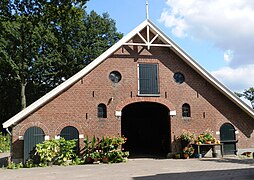|
Borne, Overijssel
Borne (Dutch pronunciation: [ˈbɔrnə] ⓘ; Tweants: Boorn) is a municipality and a town in the eastern Netherlands, in the region of Twente. Its inhabitants also have the nickname Melbuul (flour bag in Twentsch). HistoryThe earliest traces of inhabitation in Borne are archeological finds at the "Stroom Esch" and "Zuid Esch" of substantial settlements dating from the late Iron Age and the Roman period.[5] Finds from around 800 CE.,[6] the remains of two farmhouses and the grave of a man buried with his armour, a sword, lance and 16 silver denarii coined by Charlemagne near two farmhouses of the same age suggest inhabitation in the ninth century.[6] The first historical mention of Borne, under the name Borghende dates from 1206 in a document which transfers churches in Steenwijk and Borne and their possessions by Fredericus, the abbot of the monastery in Ruinen to the bishop of Utrecht, Dirk van Are in return for possessions in Drenthe.[7] The earliest phases of Borne center around the Meijershof,[8] which came into possession of the abbot of Ruinen in 1142. Until the beginning of the industrial age, Borne was an agricultural community, characterised by plaggen soil and extensive cattle farming. The main crops were rye and buckwheat.[9] Several landweren, defensive earthworks consisting or earthen walls overgrown with blackthorn (Prunus spinosa) and blackberries are still visible in the landscape.[10] Borne was originally the richterambt (judicial district) Borne, made up of the Marke Senderen (Zenderen) and Bi den Broeke (lit. "by the brook", Bornerbroek) and the hamlet of Hertme. In 1655 Hertme has evolved into an independent marke. Population centresBornerbroek, historically part of Borne, is since 2001 part of the Almelo municipality. Borne borders the municipalities of Hengelo, Hof van Twente, Dinkelland, Almelo and Tubbergen. TopographyDutch Topographic map of the municipality of Borne, June 2015. Twin townThe sister city of Borne is
Transportation
Notable people
Gallery
References
External links
|
|||||||||||||||||||||||||||||||||||||||||||||||||||
Portal di Ensiklopedia Dunia








